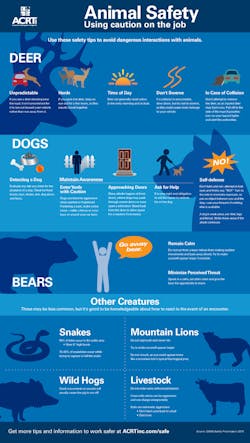While canines are “Man’s Best Friend,” approaching an unfamiliar dog has the potential for serious injury. Dogs continue to be a major concern to field employees, and it’s why there should be significant importance placed on dog bite prevention training. Aggressive dog encounters are one of the most common and serious hazards that field employees face. Nearly five million people in the United States are bitten by dogs each year. There are several tools and training sessions available to teach you the best techniques to avoid being bitten.
If entering a site with a dog is unavoidable, you should minimize the potential for an attack and be prepared if it occurs. Take a look at ACRT’s Animal Safety infographic below for essential safety tips you should know in the event of an animal encounter.
- Detecting a dog. Evaluate any site you enter for the presence of a dog. If you’re unsure if there is a dog on-site check for the telltale signs: food/water bowls, toys, chains or ties, dog doors, worn trails in the yard.
- Maintain awareness. Even if a dog is chained up, or is thought to be inside a structure, a dog may still be able to free itself. Never assume the owner has full control of a dog, even when leashed.
- Enter with caution. Dogs are provoked when startled or frightened, triggering the “fight or flight” response. If entering a yard, alert a potential dog to your presence: make some noise — rattling a fence, your keys, or sounding your car horn.
- Approaching doors. Dog attacks often happen at front doors. Dogs have the advantage of being aware of your approach, screen doors can be poor barriers, and dogs may be able to push through a solid door. Standing approximately 6 ft from the door and to the side upon approach allows your reaction time if necessary. It is your right and obligation to ask the owner to restrain their dog before entering the premises.
- Self-defense. If the worst happens and a dog attacks, minimize the possible damage. Cover your face and neck. Don’t turn and run, but attempt to lock eyes and firmly tell the dog “NO!” If the dog continues to approach, turn to the side, and take a wide stance to minimize your exposure and absorb the impact. Put something between you and the dog, such as a clipboard or hard hat. Tools such as dog bite prevention sticks and sprays may be acceptable depending upon site-specific regulations.
Deciphering dogs’ body language
Just as we do, dogs rely on body language to express themselves and communicate, according to the American Veterinary Medical Association (AVMA). Being able to decipher dogs’ body language can provide clues as to whether a dog is feeling stressed, frightened, or threatened.
The American Society for the Prevention of Cruelty to Animals names several signs related to aggression, fear, or anxiety, that can lead to a bite.
Signs of aggression include efforts to make the dog look bigger:
- Ears positioned upward and forward
- Raised fur on the back and/or tail
- Vertical tail may be wagging very quickly
- Stiff, straight-legged stance
- Staring
- Growling, lunging, or barking
Signs of fear or anxiety include efforts to make the dog look smaller:
- Cowering and/or lowering of the head
- Repeated lip licking
- Tucked tail
- Flattened ears
- Yawning
- Avoiding eye contact
- Remaining very still
- Growling or snarling
When aggressive dogs are known or expected
Be sure to review any information from the customer about bad dog/aggressive animals and contact the owner before arrival. Once you have arrived at the location, do not enter areas with posted warnings until contact with the owner has been made. If someone is available, have them secure the dog before entering the area.
Remember, you have the right and obligation to ask the owner to restrain their dog.
If you are bitten or attacked by a dog
Almost one in five people bitten by dogs require medical attention. If bitten by a dog, the AVMA provides a checklist of things you should do.
- If the dog's owner is present, request proof of rabies vaccination, and get the owner's name and contact information.
- Clean the bite wound with soap and water as soon as possible.
- Consult your doctor immediately or go to the emergency room if it's after office hours.
- Contact the dog's veterinarian to check vaccination records.
- Contact the local authorities if you have difficulties verifying vaccination records.
In the case you are bitten by a dog, the Cleveland Clinic notes, “After any bite, you should make sure you know when your last tetanus shot was — and that you’re up-to-date.”
Having a dog charge at and bite you can be scary but is also a preventable situation. Protect yourselves by reading up on best practices and taking additional dog bite prevention courses throughout your careers.
About the Author
Keith Pancake
Keith Pancake is a safety manager serving ACRT and Bermex. He has been involved in the UVM industry for over 10 years. He is an ISA Certified Arborist and Utility Specialist, an NSC certified Defensive Driving Instructor, and the 2018 Utility Arborist Association’s Silver Shield recipient.

